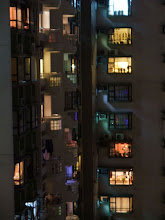So I was zapping the channels one day, and started watching Star Trek 9, Insurrection, and a interesting topic was brought up...
Artim (a child) and Data (a robot) takes interest in each other's lifestyle: wondering what is it like to be a child/ a robot. The brief conversation exchanged between them brought up a small interesting subject
--- ---
Data: Perhaps it would surprise you to know that
I have often tried to imagine what it would be like to be a child...
Artim: For one thing, your legsare shorter than everyone else's.
Data: But the are in a constant state of growth. Do you find it difficult to adapt?
A child's specifications are never the same from one moment to the next.
I a surprised that you do not ...trip over your own feet.
Atrim: Sometimes I do.
Data: My legs are eight-seven-point-two centimeters.
They were eighty-seven-point-two centimeters the day
I was created. They will be eighty-seven-point-wo centimeters the
day I go offline. My operation depends on specifications
that do not change. I...cannot imagine... the experience
of growing up or even tripping over my own feet...
Unlike robots who are brought into the world with one specification, humans (particularly Childrens) are in constant growth and therefore always changing their sizes. The growth of the human body, demands adjustments to the changing bodily measurements. Surprisingly this happens through-out our life without much awareness. Asides from new clothes and shoes to fit our dimensions, much of the changes and adjustments go unnoticed.
If we say architecture is similar to the Human Body as it breaths and has both skin and bones. Then with this argument, perhaps something is also missing. Perphas it is the growth of the building, other than the extensions and material decay, the buildings don't really transform or grow/age anyother way (or do they? )
Anyways, The readjustments we make to the on-going modifications of our growing body, is often forgotten as it become a habitual and ordinary; therefore insignificant. We have become so accustomed to re-fitting/ adjusting that we have become so unaware to it. Adaptation is second nature and hence taken advantage of.
The adaptive quality (in architectural terms?) should not be solely to site conditions and surroundings, but also to the people and development of the society (or social surroundings).
On a side note: On my journey back to Providence from Hong Kong, I was stuck in Newark because of the snow storm, I met a lady from a children's art education company. An interesting topic concerning the facilities for child development was brought up. She brought up simple issues such as the dis-coordination between children facilities and their method of development, as well as their sizes. For example, for those ages between 3- 6, the windows are too high for them to look out, the shelves are too high for them to reach. Therefore interrupting with their maturation? or advancement.
We also discussed about possible design solutions of the spaces, actually particularly about the materials used in the interior. such as mirrors which would help develop their understanding of the facial features (thus preventing them drawing the facial features all in the straight vertical line.) as well as green materials such as bamboo, cork and many more...
So the growth/ development can be considered as a type of transition from childhood to adulthood. Then perhaps one way is to rethink the design of a daycare center, or school/ nursery/ kindergarten; where the design of this space is specific to each of the stages of growth.
For example, having windows at located at different heights off the ground for the different age range..as well as furniture (which already exists) but then the design of each room for each specific age range could generate or facilitate with a child development (or understanding of the world he or she lives in) .




Or maybe the building is a child, instead of just being for children. Can we give birth to the building, teach it, let it grow learn to best fill its purpose. Check out these videos:
ReplyDeletehttp://www.kottke.org/08/08/how-buildings-learn-tv-series
I haven't watched them all...
Buildings represent a significant investment of time, capital, resources. To say that they should be a complete work immediately upon completion is maybe shortsighted.
At the very least, one could think like the Germans and demand a plan for the lifecycle of all building materials...when a building is obsolete, a plan in in place for the recycling/reuse of all its components.
I love Star Trek. About Data: do you think he learns? Certainly, he depends upon absolutes, these are given to him as programmed restraints in his computer brain, but there is no way his anyone can program him to respond to all situations. Instead, his brain is described as a "neural net" which implies it is like our brain: the hardware is able to reassemble itself in response to input. Indeed, NASA is working on software that would allow interplanetary probes to learn from their environment. In the future, preparing a probe for Mars won't involve hours of programming, but a "space probe daycare" so that it can learn how to complete its mission...
I'm rambling!